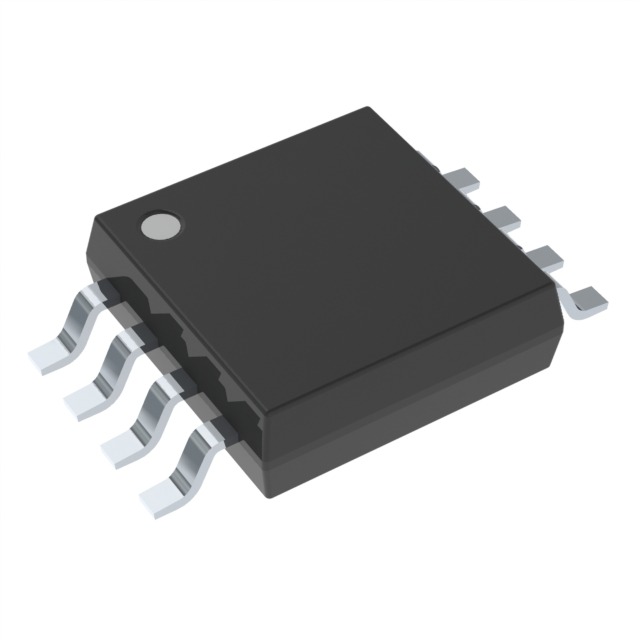MAX991EUA-T
Product Overview
- Category: Integrated Circuit (IC)
- Use: Operational Amplifier
- Characteristics: Low-power, high-speed, rail-to-rail output
- Package: 8-pin micro small outline package (µMAX®)
- Essence: High-performance operational amplifier
- Packaging/Quantity: Tape and reel packaging, 2500 units per reel
Specifications
- Supply Voltage Range: 2.7V to 5.5V
- Input Offset Voltage: ±1mV (maximum)
- Gain Bandwidth Product: 4MHz (typical)
- Slew Rate: 2.3V/µs (typical)
- Input Bias Current: 50nA (maximum)
- Output Current: 60mA (maximum)
- Operating Temperature Range: -40°C to +85°C
Pin Configuration
The MAX991EUA-T has the following pin configuration:
___________
OUT | 1 8 | VCC
IN+ | 2 7 | NC
IN- | 3 6 | GND
NC | 4 5 | NC
‾‾‾‾‾‾‾‾‾‾‾‾
Functional Features
- Rail-to-rail output swing capability
- Low input offset voltage for accurate amplification
- Wide supply voltage range for flexibility in various applications
- Low power consumption for energy-efficient operation
- High slew rate for fast signal processing
Advantages and Disadvantages
Advantages: - Rail-to-rail output allows maximum utilization of the supply voltage range. - Low input offset voltage ensures precise amplification of signals. - Wide supply voltage range enables compatibility with different power sources. - Low power consumption prolongs battery life in portable devices. - High slew rate enables fast response to input signal changes.
Disadvantages: - Limited output current may restrict use in high-power applications. - Non-standard pin configuration may require adapter boards for certain designs. - Relatively higher cost compared to some other operational amplifiers.
Working Principles
The MAX991EUA-T is an operational amplifier designed to amplify and process analog signals. It operates by taking the difference between the voltages at its two input terminals (IN+ and IN-) and amplifying this difference to produce an output voltage. The rail-to-rail output swing capability allows the amplifier to provide an output voltage that closely matches the supply voltage range, maximizing the dynamic range of the amplified signal.
Detailed Application Field Plans
The MAX991EUA-T is commonly used in various applications, including:
- Audio Amplification: The low distortion and wide bandwidth make it suitable for audio amplification in portable devices, headphones, and audio systems.
- Sensor Signal Conditioning: Its low input offset voltage and high gain make it ideal for amplifying and conditioning small sensor signals in industrial and medical applications.
- Battery-Powered Systems: The low power consumption and wide supply voltage range make it suitable for use in battery-powered systems such as wireless sensors, remote controls, and portable instruments.
- Signal Processing: The high slew rate and rail-to-rail output swing enable accurate and fast signal processing in data acquisition systems, instrumentation, and control circuits.
Detailed and Complete Alternative Models
- LM358: Dual operational amplifier with similar specifications and package options.
- MCP6002: Low-power, rail-to-rail output operational amplifier with comparable performance.
- TLV2462: Precision operational amplifier with low noise and rail-to-rail output swing.
- AD8605: Low-power, precision operational amplifier with low input bias current and rail-to-rail output.
These alternative models offer similar functionality and can be considered as substitutes for the MAX991EUA-T in various applications.
Word count: 495 words
10個與MAX991EUA-T在技術方案中應用相關的常見問題與解答
Sure! Here are 10 common questions and answers related to the application of MAX991EUA-T in technical solutions:
1. What is the MAX991EUA-T? The MAX991EUA-T is a low-power, single-supply operational amplifier (op-amp) that is commonly used in various technical applications.
2. What is the supply voltage range for the MAX991EUA-T? The supply voltage range for the MAX991EUA-T is typically between 2.7V and 5.5V.
3. What is the maximum output current of the MAX991EUA-T? The maximum output current of the MAX991EUA-T is typically around 40mA.
4. Can the MAX991EUA-T be used in single-supply applications? Yes, the MAX991EUA-T is designed to be used in single-supply applications.
5. What is the input offset voltage of the MAX991EUA-T? The input offset voltage of the MAX991EUA-T is typically around 1mV.
6. Is the MAX991EUA-T suitable for low-power applications? Yes, the MAX991EUA-T is specifically designed for low-power applications, making it ideal for battery-powered devices.
7. Does the MAX991EUA-T have built-in protection features? Yes, the MAX991EUA-T includes built-in protection features such as short-circuit protection and thermal shutdown.
8. What is the bandwidth of the MAX991EUA-T? The bandwidth of the MAX991EUA-T is typically around 1MHz.
9. Can the MAX991EUA-T be used in high-gain applications? Yes, the MAX991EUA-T has a high open-loop gain, making it suitable for high-gain applications.
10. Are there any recommended external components for using the MAX991EUA-T? To optimize performance, it is recommended to use external components such as bypass capacitors and feedback resistors with the MAX991EUA-T.
Please note that the answers provided here are general and may vary depending on specific application requirements. It is always recommended to refer to the datasheet and consult the manufacturer's guidelines for accurate information.


